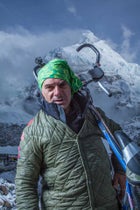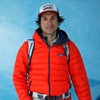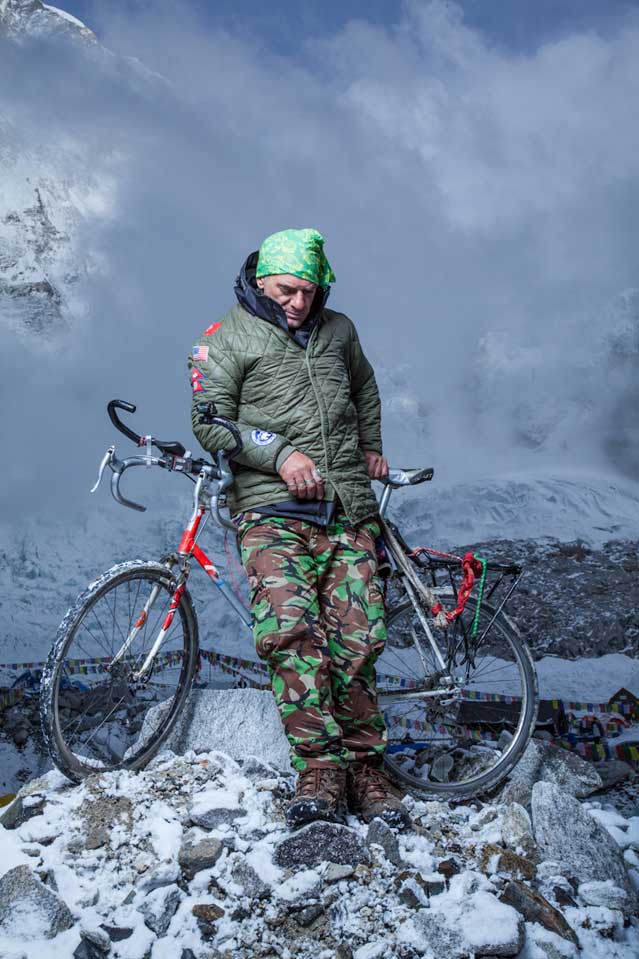FOR THE LAST several weeks here in Base Camp, people have been curious about the American clad in camouflage pants and a Keffiyeh, pushing a 33-pound, steel-frame single speed around Base Camp. His name is Aydin Irmak, and he’s a 46-year-old Turkish New Yorker. When I first saw him in Pheriche, about a two-day walk down valley from Everest Base Camp, I asked Irmak where he was taking the bike. His response, “Heaven.”


The short version of Irmak’s story is that he plans to carry his bike to the summit. He’s not trying to raise awareness for any cause, not trying to beam images of himself to schoolchildren back home, not trying to find fame and, in fact, is trying very hard to keep a low profile in Base Camp. Too many people have already let him know that his quest is foolish, dangerous, irresponsible, or worse. But like most New Yorkers, he doesn’t care what you think.
The long version—as Imrak tells it—is that around 1990 he immigrated to the U.S. from Turkey when he was 22 and spent several months pumping gas in Long Island City. A year later, he was driving a yellow cab. A year after that, he was studying finance at New York University. By 1994, Imrak had opened an industrial design store called Ageless Home at 74th and Lexington, where, he says, he was serving big-money clients from the Upper East Side, “Like Bloomberg and De Rothschild.” The enterprise thrived, until sometime after the September 11 attacks. Business slumped. Rent went up from $7,000 per month to $21,000, and, by 2005, he’d closed his shop, filed for bankruptcy, divorced his wife, and started wandering. For the next few years, Irmak walked from Ushuaia, Argentina, to São Paulo, Brazil. He worked as an actor. Around 2008, he returned to New York and, eventually, became homeless.
According to Irmak, his homelessness was by choice—”a four-month street retreat”—during which period he slept in a large cardboard box under the Queensborough Bridge and in Long Island City. Sometime in 2009, he started fixing discarded bikes he found around the city and selling them on Craigslist.
“One day, I find this bicycle,” says Imrak, referring to the bike he brought to Base Camp. “And I thought: What am I going to do with this bike? And then I thought … North Pole.” He’d just made $20,000 designing the inside of a Long Island coffee shop, and used the money to finance the adventure. In May 2010, he bought a ticket to Amsterdam and rode and sailed his way north to the Arctic Circle at Svalbard, Norwary. His arrival was not as climatic—or illuminating—as he had hoped. “Why the fuck did I come here?” he asked himself. “Could I live here? No.”
So Imrak turned around and began pedaling toward Russia. By December, he’d crossed 19 countries and landed in Bangkok. He spent 2011 hopscotching his way back across Asia—Malayasia, Indonesia, Singapore, Laos, China. From Tibet, he crossed 17,000-foot Thang La Pass into Nepal and rode west to Kathmandu, where another thought popped into his head: Everest.
“I met a Sherpa in Kathmandu and asked him if he thought I could go to the top,” says Irmak. “He said, ‘Sure,’ and brought me to Thamserkut.”
According to Irmak, the marketing manager at the Kathmandu-based outfitter told him it was a great idea and that they would apply for a permit directly through the tourism ministry. “Mr. Secretary of the permit department called me and said, ‘Congratulations you’re the first one.'” He borrowed $35,000 from a close friend in America for the climbing and permit fee. Four days after handing the money to Nepal’s permit department, a representative called him to say that another team—Italian mountain biker , who would be guided by alpinist Simone Moro—had been approved. Irmak’s permit was invalidated.
Irmak stormed into the office of the bureaucrat he’d been working with. “I opened the door like John Wayne,” says Irmak. “He said, ‘Out.’ I sat down.” Irmak says he grabbed a hold of the bureaucrat, pushed him down into his seat, and pounded the table and asked, ‘Who the fuck are you to tell me I don’t go?’ I told him I’d go get gas and burn myself.”
Amazingly, Irmak was reissued a permit, but only to bring his bike as far as Camp IV on the South Col. Still, he considered it a victory. Even so, it hasn’t been easy for him at Base Camp. Before coming here, Irmak had never worn crampons. During his first acclimatizing rotation up to Camp I, he forgot his jacket and had to return to Base Camp. Then, a few days ago, as I was shooting portraits of him for this story, a ranger from , which manages Base Camp and the Everest area, showed up and told him that while he might have a permit from the ministry, he apparently also needs one from the park as well.
Irmak is convinced he’s the target of government fraud. I told him it seemed more like garden variety incompetence. Either way, he’s now in limbo, waiting for two government agencies to decide whether his permit to carry a bike to Camp IV is valid. If it isn’t, don’t expect Irmak to leave. He’s not the type to take no for an answer.
–Grayson Schaffer
To commemorate the 50th anniversary of the first American ascent of Everest and its then-unclimbed West Ridge, Eddie Bauer has sent a team of seven mountaineers to repeat the historic climbs. ���ϳԹ��� Magazine senior editor Grayson Schaffer is currently embedded with the team at Base Camp, sending back daily dispatches, including stories, photos, and videos. A team sponsored by The North Face and National Geographic is also planning on ascending the notoriously treacherous West Ridge, a route nearly as many climbers have died on as have summitted. Schaffer will be covering both attempts, as well as everything else that happens at Base Camp, until early June.


